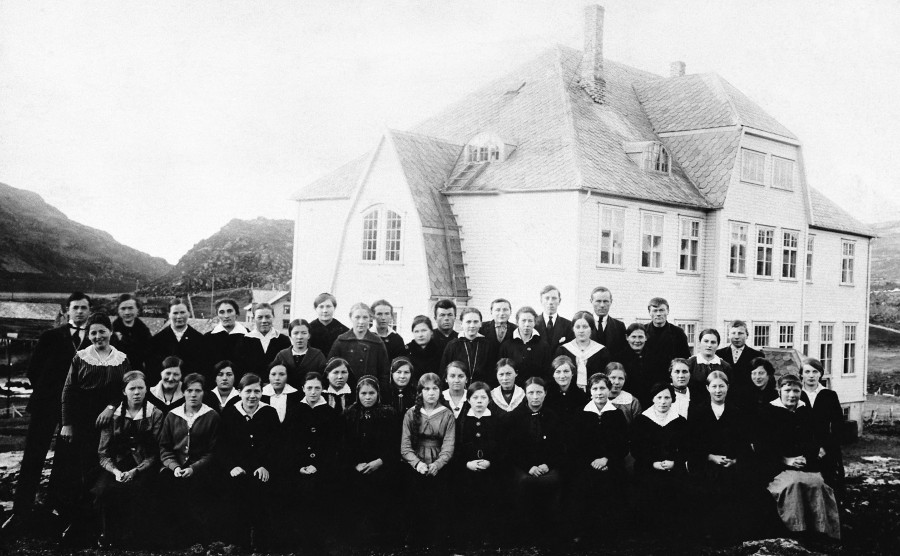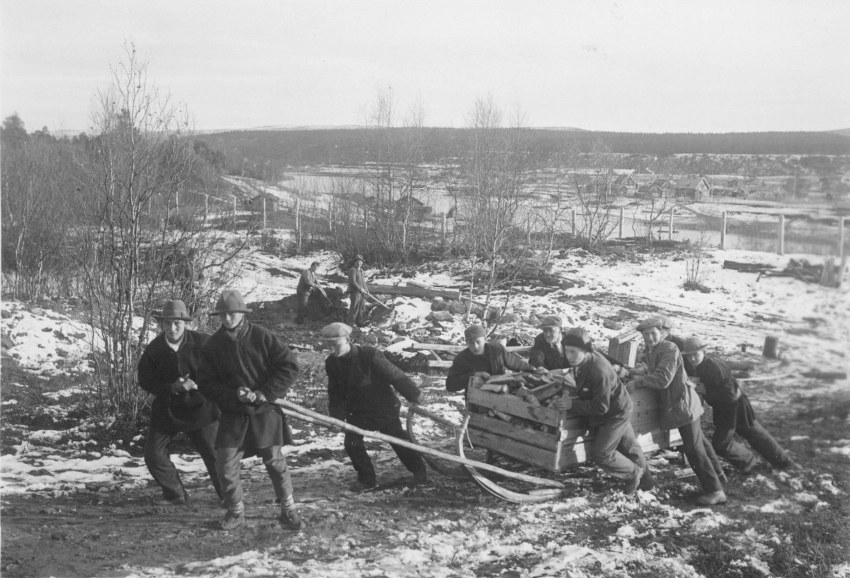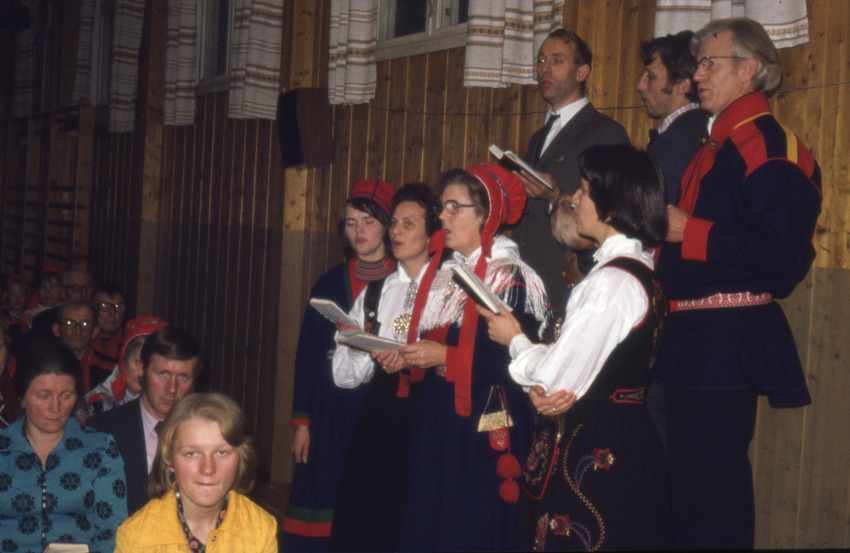 Sámegillii
Sámegillii  På norsk
På norsk
New articles for Ávvir 2013
32. 14.09.2013
Do you know Sami school history?Here we present a series of articles printed in Sami language in the newspapers Min Áigi and Ávvir from 2007 to 2013. The basis of the articles are stories which have been collected through the project “Sami school history”. There are edited 6 books with stories and articles from school life in the Norwegian part of Sápmi. In these articles there are many quotes from the books, and we refer to the articles the quotes are taken from, to make it possible to read the entire stories there.The chief editor of Sami school history, Svein Lund, is editing this series of articles. In addition Elfrid Boine, Siri Broch Johansen and Siv Rasmussen are part of the editorial staff.
|
The first year the school was running a Sami teacher, Hans Baukop from Porsanger, was working there. He later became teacher in Polmak, and there he got into quarrels with the director of schools because he used Sami in the teaching.
 | Øytun álbmotallaskuvla sullii 1920. (Govva: Finmarksbiblioteket) |
The school was moved to Alta in 1967, and has been there since. The three organizations that started the school are still the owners. There was a discontentment within the Sami mission that Sami had such a limited focus in the school, and in connection with the moving to Alta in 1967 there were forces which wished for the Sami mission to draw back from Øytun and rather concentrate on activities aimed more directly at the Sami population. Still the majority decided that the Sami mission should continue the collaboration.
In the 1970's Øytun introduced Sami leather work as a subject of teaching. Later the school has changed to a complete wildlife profile, with «Sami culture and reindeer herding» as one of the optional courses.
When I asked the Sami mission about the Sami offer in Øytun in 2001, administrative secretary Randi Rian Solberg replied: «Since NSM (Norwegian Sami Mission) has been running DSF (the Sami folk high school) Øytun folk high school has not had any Sami as part of it's program. As DSF now ha been closed down Øytun has been considering and is planning a separate Sami related course of study.»
01.03.2002 on the other hand the headmaster at Øytun says to Min Áigi: «that there are no plans to start a separate Sami course of study at the school, but rather to strengthen the Sami profile in all courses of study».
Øytun managed to get an extra governmental support, arguing that the school would take over the tasks DSF had. This lead to an increase of the number of students, but no more Sami content in the teaching.
The first who made an attempt to get such a school started was probably Jens Otterbech, already in 1911. When it did not succeed to introduce a Sami offer in Øytun, Otterbech and Finnemisjonsforbundet (...) concentrated even more on developing a separate Sami folk high school. Otterbech fought for the Sami folk high school until he died in 1921. After his death Jacob Børretzen in particular fought for the matter within the Sami mission.
Some years later the thought of a folk high school was introduced by Per Fokstad and Tana sámi searvi. Fokstad sent a plan for a Sami folk high school to the Ministry of Church and Education in 1923, and resumed his suggestions to the parliamentary school commission in 1926. He also suggested Sami courses of study in the other folk high schools in the county:
It will be established parallell classes in the two county schools in Finnmark and at Øytun folk high school. The language of teaching will be Sami, with the exception of lessons in Norwegian language. It must be calculated a greater number of lessons in Norwegian for Sami youth than what has been calculated until now. — Lectures on Sami culture and the history of the Sami. — Woodwork and needlecraft: Sami handicrafts. Teachers: Sami. Until this has been carried out there should be employed a Sami born teacher straight away in all of the folk high schools.
 | Sami folk high school: Pupils had to carry firewood to the school. Probably the picture is from 1936–38. (Photo lent by Norgga Sámemišuvdna) |
The proposals of Fokstad was completely turned down by the school authorities, and the director of schools Brygfjeld stated: «The demand to establish a Lappish (Sami) folk high school did not come from the Lapps in Finnmark, but from Norwegians from outside the county with little or no knowledge about the conditions in the area. They believe to be able to cultivate this small sparse settled nature people and change it to a people of culture with the basis in it's own language. The Lapps have neither had the ability nor will to use their language as a written language.»
Among others who were enthusiastic about a Sami folk high school early on was the priest in Lyngen, Peter Astrup. In 1922 he wrote a letter to the director of schools and the ministry advocating a Sami folk high school in Karasjok. Astrup envisioned this school as a public school. He wrote about the matter both to the director of schools in Finnmark and to a Principal Officer in the Ministry of Church and Education. In the latter this is how he states the reasons for the establishing of the school:
«The plan would be as for the other folk high schools, but with the exception
of the Norwegian lessons one would try to use the Lappish language as much as possible. The idea of the school is to teach the Sami to love and protect their own roots and from their own roots to grow in culture and character. It should aim for two things:
1) to ease the transition to Norwegian cultural life without becoming rootless people with some sort of Norwegian beggar culture and 2) to preserve the Sami national values that can endure.
An intense discussion rose, for instance in the newspapers. Among those who committed themselves for such a school was the south Sami Daniel Mortensson, editor of the newspaper Waren Sardne.
An attempt from the Sami mission to take over the East-Finnmark county school in Tana was rejected by the county council in 1935. At the same time the county council advised not to give governmental support to a folk high school for Sami and expressed that the Sami themselves did not want a separate school for Sami. Again a debate in the newspapers rose, showing that strong forces was opposing any kind of initiative founded on Sami language and culture.
In the newspaper Finnmarksposten 07.02.1935 the view of the Sami mission is referred, and there is also an unsigned comment (probably from the editorial staff) which we quote here:
On today's frontpage we print an article on Sami folk high school in Finnmark. The secretary general of Norwegian Finnemisjonsselskap (...), Heiervang among other things states that such a school «plainly is a duty of the nation», and furthermore that the teaching will take place in Sami.
On this occasion we will not discuss the legitimacy of such a school, but we will pinpoint the citation above from the secretary general. It is a national duty to establish a folk high school with Sami as the language of teaching, he says.
We have always believed it to be a national duty to teach all Norwegian citizens to speak Norwegian. In our opinion we have more than enough of language division in the country. We have two equal language variants.
Should it now be worked to make a third language recognized with all the official rights?We fear that this will be the consequence. And in that case calling this a national duty is ill-fitting in our opinion.
The thought can be well intentioned, but it is not national. The nationality thought is about a united Norway, linguistically and culturally. Not a cleft and divided country.
The negative attitude from the county authorities made the Sami mission flare up, and in 1935 the assembly council passed unanimously: «The assembly council urges the main council to look into the possibility to initiate a Christian, moveable folk high school for Sami in Finnmark, and get this started as soon as possible – despite that county- or governmental financial support can not be achieved.» In 1936 the Sami folk high school finally got started, with Ottar Bondevik as the first headmaster. The school did not have it's own housing and the war put a stop to the plans for construction.
Although many wished for the Sami folk high school to be an alternative to the politics of norwegianization, the school was depending on governmental support, which made it no use to challenge the government too much. The director of schools Lyder Aarseth was a good support for the school, but simultaneously he made sure the school stayed within the governmental school politics. On request he wrote a salutation for the 50th anniversary of the Sami mission in 1938 and then he wrote about DSF (the Sami folk high school):
«This school is no reaction against the norwegianization, but a means to lift the Sami youth up to equal rights with all other youth in the country.»
Evidently there has been struggles within the Sami mission regarding both wether the school should be started and what it should be. But it has been difficult to find documentation on this struggle. In the Sami mission's own historiography there is a strong tendency to gloss over internal discords, although these at times have been strong. Paul Ryan, who himself was headmaster at the school 1957–77 still says a lot when he describes the school like this: «The plan and the content of the school was not the same as what Otterbech had envisioned. But yet it was a school different to all other schools in the country. Although the use of Sami did not have a political aim, the language was used both in singing, in church services and meetings. Moreover there was given teaching in horn and bone crafts, sewing of national costumes and band weaving. The school had more or less only Sami pupils and naturally Sami was the spoken language of daily life.»
After the war the debate about who should run the folk high school for the Sami resurfaced. The coordination committee for the school system and Finnmark county council proposed that it should be a governmental task. In the resolution from 28.05.1948 the committee gives a pronounced expression of scepticism of the way the Sami mission ran the school: «The coordination committee for the school system is of the opinion that the time now has come to construct a special folk high school for the Sami in Finnmark. The school, which the Finnemisjonsselskapet (…) had in Karasjok before the war and which was destroyed in 1944, had its special aims and can not meet the demands one has to make for an appropriate school for youth. It must be a school set up and controlled by the national authorities in accordance with the rules that applies to normal folk high schools, with subjects and a plan for division of subjects like them. At the same time it has to fullfil its special task as school for Sami youth.»
The Director of schools Lyder Aarseth on the other hand was of the opinion that the Sami mission should continue to run the school. His recommendation was decisive when the Ministry gave it's approval and financial support for the start up. The school was started in 1949, and in 1951 it could finally move into it's own buildings.
 | Sami folk high school: Teacher' quiore is singing, 1976. First row from the left: Unni Steinfjell, Oddlaug Vågsås, Åse Ryan, Margot Grimstad. 2. row from left: Herman Vågsås, Arne Ola Grimstad, Paul Ryan. (Photo: Norsk Samemisjon) |